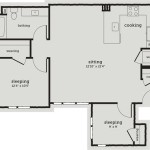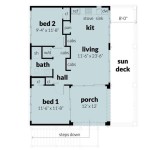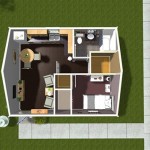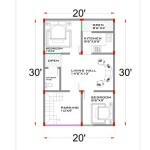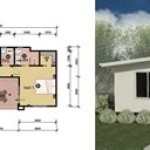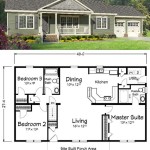Single Story House Plans with Vaulted Ceilings: Enhancing Space and Light
Single-story house plans, often praised for their accessibility and ease of maintenance, are increasingly incorporating vaulted ceilings to achieve a greater sense of spaciousness and visual appeal. This design choice transcends simple aesthetics, playing a significant role in natural light distribution, thermal comfort, and overall home value. Understanding the intricacies of integrating vaulted ceilings into single-story designs is crucial for homeowners, architects, and builders alike.
A vaulted ceiling, by definition, is any ceiling that is higher than a standard flat ceiling and slopes upwards. This slope creates a heightened sense of volume within the room, making it feel larger and more open. The increased surface area also allows for more natural light to enter the space, often through strategically placed windows or skylights. The combination of these elements contributes to a more inviting and comfortable living environment.
The incorporation of vaulted ceilings into single-story homes is not without its considerations. Careful planning is essential to ensure structural integrity, energy efficiency, and aesthetic harmony with the overall design. Factors such as roof pitch, insulation, and window placement must be carefully evaluated to maximize the benefits and minimize potential drawbacks.
Key Point 1: The Benefits of Vaulted Ceilings in Single Story Homes
The advantages of incorporating vaulted ceilings into single-story house plans are multi-faceted. These benefits extend beyond mere aesthetics, impacting various aspects of the living experience.
Firstly, vaulted ceilings significantly enhance the perception of space. In single-story homes, where horizontal space might be limited, the vertical expansion created by a vaulted ceiling can alleviate feelings of confinement. This is particularly beneficial in smaller homes or in rooms where maximizing the sense of openness is a priority. The increased volume allows for better airflow and a more breathable atmosphere.
Secondly, vaulted ceilings facilitate improved natural light distribution. The increased surface area provides more opportunities for incorporating windows and skylights. Natural light is not only aesthetically pleasing but also has demonstrable benefits for mood and well-being. Larger windows, strategically placed to capture sunlight throughout the day, can reduce the need for artificial lighting, leading to energy savings.
Thirdly, vaulted ceilings can add significant value to a property. Homes with unique architectural features, such as vaulted ceilings, tend to be more desirable to potential buyers. The perceived luxury and spaciousness associated with this design element can translate into a higher market value. This is particularly true in areas where single-story homes are prevalent, as vaulted ceilings can help differentiate a property from its competitors.
Finally, from a design perspective, vaulted ceilings offer a greater level of architectural flexibility. They can be incorporated into various styles, from modern and contemporary to traditional and rustic. The shape and style of the vault can be tailored to complement the overall aesthetic of the home, creating a cohesive and visually appealing design.
Key Point 2: Design Considerations for Vaulted Ceilings
Designing a single-story house plan with vaulted ceilings requires careful attention to several key considerations. These factors directly impact the structural integrity, energy efficiency, and overall aesthetic appeal of the home.
The roof pitch is a crucial element in determining the feasibility and aesthetics of a vaulted ceiling. A steeper roof pitch generally allows for a more dramatic vault, while a shallower pitch may limit the height and shape of the ceiling. The roof pitch must also be sufficient to ensure proper drainage and prevent water damage. Architects and builders must carefully consider the local climate and building codes when determining the optimal roof pitch.
Insulation is another critical factor. Vaulted ceilings, due to their increased surface area, can be more susceptible to heat loss in colder climates and heat gain in warmer climates. Proper insulation is essential to maintain a comfortable indoor temperature and minimize energy consumption. Various insulation materials, such as fiberglass, spray foam, and cellulose, can be used to insulate a vaulted ceiling. The choice of insulation material will depend on factors such as cost, R-value (a measure of thermal resistance), and ease of installation.
Window placement plays a crucial role in maximizing the benefits of a vaulted ceiling. Strategically placed windows and skylights can capture sunlight throughout the day, providing natural light and reducing the need for artificial lighting. The size and type of windows should be carefully selected to balance natural light with energy efficiency. Considerations such as solar heat gain coefficient (SHGC) and U-factor (a measure of heat transfer) should be taken into account when choosing windows.
Structural support is paramount when incorporating vaulted ceilings. The altered roof structure requires careful engineering to ensure stability and prevent structural issues. Load-bearing walls and beams may need to be reinforced or repositioned to accommodate the vaulted ceiling. A qualified structural engineer should be consulted to ensure that the design meets all applicable building codes and safety standards.
Finally, the aesthetic integration of the vaulted ceiling is crucial. The design of the ceiling should complement the overall style of the home. Considerations such as the shape of the vault, the use of exposed beams, and the choice of finishes should be carefully considered. Details such as lighting fixtures and ceiling fans should also be carefully chosen to enhance the aesthetic appeal of the vaulted ceiling.
Key Point 3: Different Types of Vaulted Ceilings Suitable for Single Story Homes
There are various types of vaulted ceilings that can be incorporated into single-story house plans, each offering its unique aesthetic and structural characteristics. Understanding these different types is essential for making informed design choices.
A cathedral ceiling is a symmetrical vault that follows the pitch of the roof. This type of ceiling creates a dramatic and open space, making it a popular choice for living rooms and master bedrooms. Cathedral ceilings are relatively simple to construct, making them a cost-effective option compared to more complex vault designs. However, they can be more challenging to insulate properly due to their shape and size.
A barrel vault is a semi-circular arch that spans the length of the room. This type of ceiling creates a smooth and flowing aesthetic, reminiscent of Roman architecture. Barrel vaults are often used in hallways and kitchens, adding a touch of elegance and sophistication. Constructing a barrel vault requires specialized skills and materials, making it a more expensive option than a cathedral ceiling.
A groin vault is created by the intersection of two barrel vaults at right angles. This type of ceiling creates a complex and visually interesting design, often used in larger spaces such as living rooms and entryways. Groin vaults are structurally more complex than barrel vaults and require careful engineering to ensure stability.
A tray ceiling features a recessed center section, creating a tiered effect. This type of ceiling provides a subtle sense of height and dimension, making it a popular choice for dining rooms and bedrooms. Tray ceilings are relatively easy to construct and can be incorporated into various architectural styles.
A shed ceiling, also known as a single-slope ceiling, slopes upwards in one direction only. This type of ceiling is often used in modern and contemporary homes, creating a clean and minimalist aesthetic. Shed ceilings are relatively simple to construct and can be easily integrated with clerestory windows to maximize natural light.
The choice of vaulted ceiling type will depend on various factors, including the architectural style of the home, the desired aesthetic, the budget, and the structural considerations. Consulting with an architect or builder is essential to determine the most appropriate type of vaulted ceiling for a specific project.
In conclusion, integrating vaulted ceilings into single-story house plans presents a compelling design strategy to enhance space, light, and overall property value. By carefully considering the design implications, choosing the appropriate vault type, and prioritizing structural integrity and energy efficiency, homeowners can create a living environment that is both aesthetically pleasing and functionally superior.

One Story House Plan With Vaulted Ceilings And Rear Grilling Porch 70582mk Architectural Designs Plans

Ranch House Plan With Vaulted Ceilings 68419vr Architectural Designs Plans

Rustic House Plans Our 10 Most Popular Home

Cathedral Ceiling House Plans Small W High Ceilings

Rustic House Plans Our 10 Most Popular Home

Plan 051h 0205 The House
House Plan Of The Week One Story Barndominium With 14 Foot Vaulted Ceiling Builder

One Level House Plan With Cathedral Ceilings In Living Room 860029mcd Architectural Designs Plans

Plan 025l 0040 The House

House Plan 4 Bedrooms 3 Bathrooms 3942 Drummond Plans

